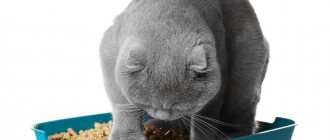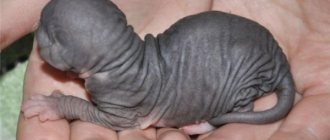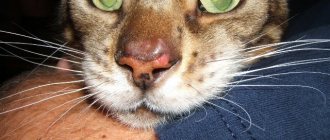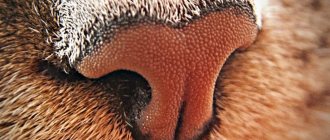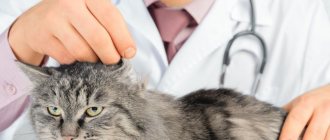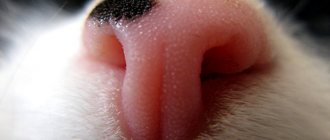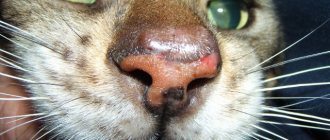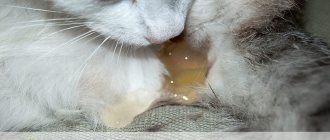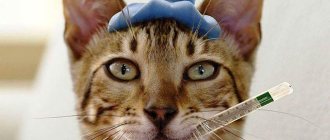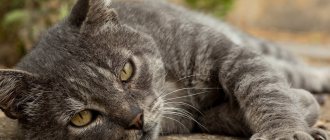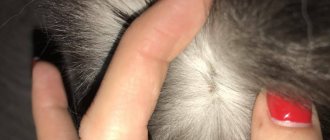Normally, a cat's feces are dark brown, well-formed, and look like a smooth sausage without foreign inclusions. But sometimes the color of stool for some reason becomes too dark or light, foul-smelling, liquid or hard. In such a situation, you should monitor the pet’s behavior, because often suspicious feces indicate the occurrence of a dangerous disease in the body, which cannot be started.
What's the normal color?
Feces in cats, like in humans, can tell everything about their health. The cat poops in dense, well-formed masses that are brown or dark brown in color. The consistency of excrement depends on the content of liquid, fat, and mucous components. The smell of feces is not unpleasant, not strong, this smell is called feces. If the diet is dominated by dairy and fermented milk products, cereals, and vegetables, the mass acquires a light brown tint. When a pet eats mainly meat, the excrement becomes a more saturated dark color.
When a visit to the vet should not be postponed
Urgent veterinary care is needed for your pet when the following additional symptoms occur:
- stomach ache;
- plaintive meow;
- temperature above 40 °C;
- diarrhea;
- vomit;
- refusal to eat;
- blood clots in excrement.
The most dangerous sign is the appearance of melena - feces with a tarry consistency, indicating large-scale bleeding.
Reasons for changes
If the color is dark
Very dark, almost black stool with an unpleasant odor indicates digestive problems. If food is not fully digested in the stomach and intestines, fermentation processes soon develop in these organs. Food particles rot, pathogenic microflora actively multiply, which is why the animal develops black stool.
Green color
Often, stool becomes like this due to the use of antibiotics by animals.
Dark green stool is often a symptom of ulcerative colitis or indicates liver problems. In the latter case, the cause is the presence of bilirubin in the stool, which should normally be absent. Green feces often appear in pets undergoing treatment with antibacterial agents. However, upon completion of therapy, the color should return to normal; if this does not happen, it is necessary to urgently show your pet to a veterinarian.
Light color
Pale, smelly, grayish feces appear in a kitten or adult cat due to the progression of inflammation of the gallbladder and ducts. Another reason why stool becomes pale is viral infectious diseases leading to liver dysfunction. Worm infestation also often contributes to constipation and the presence of depigmented excrement.
Light-colored feces occur in cats whose intestinal evacuation function is increased. As a result of the active promotion of chyme, it is not fully processed by gastric and intestinal juices. At the exit, the mass remains light because the nutrients from it are not completely adsorbed.
Melena or black mass
When there is gastric bleeding, the pet feels weak.
Often, black feces in a cat indicate extensive internal bleeding localized in one of the upper parts of the stomach. In this case, the blood enters the digestive organs and is processed there by enzymes. Melena is usually not the only symptom of the disorder. Along the way, the cat exhibits the following symptoms:
- nausea, vomiting;
- weakness;
- deterioration of general condition;
- heat;
- fainting or coma.
Other shades
Cat feces may also have the following colors:
Redness in the stool is characteristic of bleeding in the intestinal area.
- Red. If the black color of excrement indicates gastric bleeding, then red is evidence of intestinal bleeding. Feces can be solid or liquid, it all depends on the nature of the disease.
- Yellow. Speaks of gastric dysfunction and lack of enzymes involved in food digestion.
- Orange. Often indicates liver disease, accompanied by increased production of bilirubin. In addition, feces may turn orange due to your pet eating food with chemical dyes.
Black feces in a kitten
If an adult cat is sick, this is bad. But if a little kitten gets sick, it can end tragically for his life. The normal color of a kitten's stool should be brown. If the stool turns black, diarrhea with mucus or constipation appears, it means that the pet’s digestive system is not functioning well. The reason may be:
- stress;
- transition from cat milk to adult food;
- binge eating;
- allergic reaction to products;
- infectious diseases.
Accompanying signs: the kitten refuses to eat, its stomach is swollen, the stool contains mucus and blood, loose stools that have an unpleasant odor and are black.
Diagnostic methods
To understand the reason for the change in the properties of excrement in an animal, it can undergo gastroscopy.
Before you begin to treat a disease, it is necessary to find out its causes and establish an accurate diagnosis. Therefore, you cannot do without a visit to the doctor. During the initial examination, the doctor will ask the owner how long the animal has been suffering from this condition, what other symptoms are present, and collect other important information. To confirm the diagnosis, a referral is given for the following additional diagnostic procedures:
- urine and blood analysis;
- biochemistry;
- microscopic examination of feces;
- radiography;
- Ultrasound of internal organs;
- gastroscopy.
Nutrition
Let's start with the last reason. A question that Murok and Barsikov owners often ask is whether cats can have raw meat? They can do anything, but their usefulness is in question. Cats and cats are allowed to eat raw meat in small quantities. Just before you treat your pet to something tasty, you need to defrost and scald the product with boiling water.
The reasons for black feces in cats lie in overeating meat. When the pet has enjoyed a hearty meal the day before, the owner will receive a surprise in the morning. In this case, panic is not appropriate, because there is nothing terrible. A completely normal reaction of the body to “overeating” raw meat.
By the way, if the animal takes any nutritional supplements containing iron, then black feces are completely normal. The same can be said for foods high in iron.
What treatment is prescribed?
Medication
Depending on the diagnosis, the veterinarian selects the most optimal treatment regimen, which often includes the following groups of drugs:
Dicynone is able to stop a minor source of bleeding in an animal.
- Hemostatic. If diagnostics show that the cat is developing internal bleeding, but it is not life-threatening, the doctor will prescribe medications that can prevent the loss of vital fluid. Effective drugs in this group: “Dicinon”;
- "Tranexam";
- "Vikasol".
- "Penicillin";
- "Interferon";
- "Pyrantel";
- "Maalox";
Surgical
Sometimes surgery is the only option for an animal to return to normal.
Sometimes it is impossible to normalize a pet’s condition with medications alone, for example, with heavy internal bleeding. To save the animal's life, the doctor decides to perform surgical treatment. The manipulations are performed under general anesthesia. After the operation, a long recovery will be required, during which it is important for the owner to control the diet of his four-legged friend, as well as give him medications prescribed by the doctor to prevent the development of inflammatory processes and increase the body's defenses.
Treatment of black feces in cats
If the presence of blood in the stool is detected, the doctor prescribes hemostatic drugs. Treatment is carried out in a hospital, as the drugs are administered intravenously or intramuscularly. These are the following medications:
- Dicynone. The drug is administered 2 times a day intramuscularly. Per 1 kg of body weight - 10-12 mg of solution. The course of treatment is 3 days.
- Tranexam. The drug is administered intramuscularly or intravenously every 8 hours. Dosage: per 1 kg of weight - 10-15 mg. As soon as the bleeding stops, treatment is stopped.
- Vikasol 1%. It is administered intramuscularly at 2 mg per 1 kg of weight. Treatment lasts 3-5 days.
- Aminocaproic acid 5%. The drug is administered intravenously or given to drink (per 1 kg of weight - 7-10 mg). Intravenous dosage: 1 mg of the substance per 1 kg of animal weight. Dosage amount: 5 times a day.
Only when the bleeding stops do they begin to treat the underlying disease. To eliminate antiviral pathologies, Interferon, Cycloferon and Gamavit are used, against bacterial ones - Amoxicillin, Gentamicin and Tetracycline. To get rid of worms, Dirofen, Drontal and Pratel are used. Among the gastroprotectors for pets, Almagel, Phosphalugel and De-Nol can be used.
To prevent self-medication from leading to complications and the animal dying, it is better to consult a veterinarian. Based on the identified disease, each animal is prescribed individual treatment.
All information posted on the site is provided in accordance with the User Agreement and is not a direct instruction to action. We strongly recommend that before using any product, you must obtain a face-to-face consultation at an accredited veterinary clinic.
Prevention
To ensure that your cat does not have problems with defecation, and that the color and consistency of feces always corresponds to the norm, it is important to follow simple preventive rules. Once every six months, the animal should be treated with anthelmintic drugs and treated for cat lice and fleas. In addition, it is worth adjusting the diet and, if necessary, switching to ready-made medicinal factory feed. If your pet's stool stinks and has an uncharacteristic color, it is forbidden to self-medicate. Only a treatment regimen correctly selected by a doctor will help eliminate the disease and prevent complications.
What might the stool of a sick animal look like?
In the tray of his pet, the owner may find feces that differ in shape:
- ointment-like;
- mushy;
- liquid;
- foamy;
- in the form of “goat peas”;
- in the form of a tape or pencil.
By smell they distinguish: sour, rancid, putrefactive.
- Feces acquire a sour smell when the absorption of fatty acids in the small intestine is disrupted or due to fermentation processes in the large intestine.
- An unpleasant odor, similar to the smell of bad oil, occurs when the secretory function of the pancreas is disrupted or when the flow of bile is disrupted.
- The smell of rotting occurs when digestion in the stomach is disrupted, dyspepsia develops with the proliferation of putrefactive microflora in the intestines. Or the cat suffers from colitis with ulcerations.
It is customary to distinguish feces by color:
- red (beetroot);
- black (tarry);
- dark brown;
- light brown;
- with a scarlet admixture (undigested blood);
- yellow;
- light yellow;
- greenish yellow;
- bleached slightly yellow, gray, gray-white.
A healthy cat can have red or beetroot feces if it has eaten beets or food colored with bright dyes. This coloring is not pathological and soon the stool acquires a normal color.
